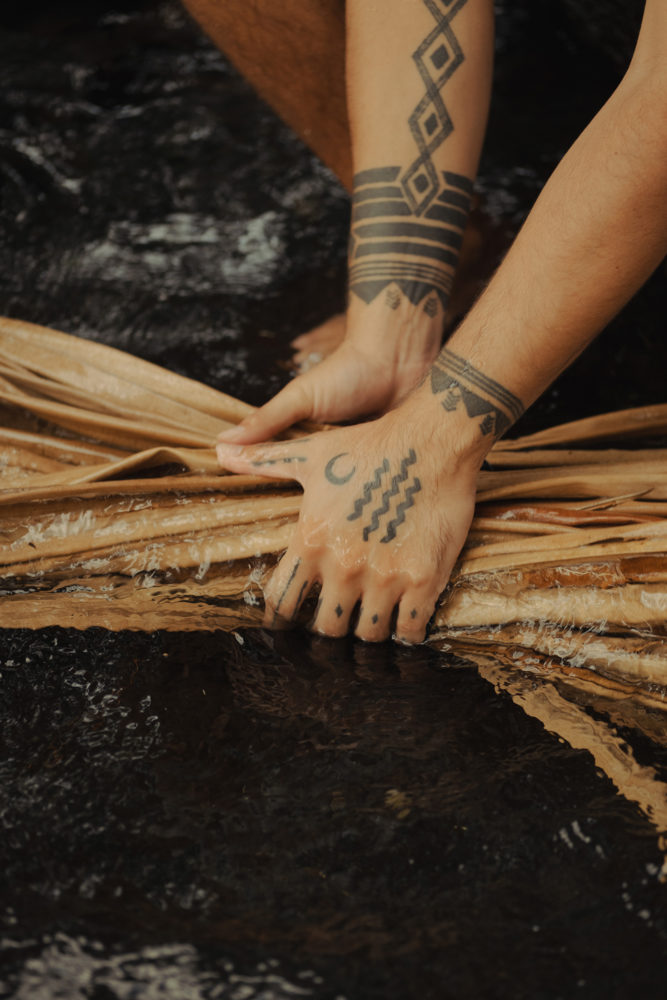Through ulana lau hala, Kekai Naone is weaving time together, connecting past to future with purpose, pragmatism, and personality.
In a quiet neighborhood in Hilo, a small stool stands in the middle Kekai Naone’s living room, its seat wrapped in an elegant twist of alternating patterns comprised of thin strips of light and dark lau hala. Like much of Naone’s work, the stool cover is beautiful, playful, and practical—an embodiment of the 26-year-old weaver’s approach to ulana lau hala, which is the weaving of dried pandanus leaves by hand. Chatting with a friend recently about how to best describe work like this, he was struck by her appraisal of his practice: “‘You don’t make culture for art. You make art for culture,’” he recalls, gesturing towards the stool. “It’s utilitarian, but it’s beautiful at the same time. And that was definitely a focal point for Hawaiians,” Naone explains. “We don’t want to have ugly things in our houses, so weaving wasn’t necessarily art—it was functional beauty.”
Functional is almost an understatement. Prior to Western contact, items made from lau hala—the leaves of the hala tree—were ubiquitous in everyday life. Floor mats, sleeping pads, baskets, cordage, and house thatching were all made from lau hala, and weaving was held as a point of pride as each family often had carefully guarded techniques. Over time, however, with the rapid decline of the Hawaiian population post-contact and imported materials becoming more commonly used, lau hala goods came to be seen as works of art meant to be treasured, not regularly used.
Naone’s dedicated lau hala Instagram account, @pikohinano, delights followers with a fresh take on the traditional practice. Intricately woven stools, water bottle sleeves, pāpale (bowties, even!) of all shapes and sizes, Naone’s creations are designed to be seen, loved, and used often, inviting you to rethink your perspective on what constitutes mea lau hala, or lau hala objects, and how to embrace it. “A lot of people only wear their lau hala to church or parties. They don’t really know what they’re supposed to do with it, and I think that adds to the relegation of it to being super sacred or only for special occasions,” Naone says. “But, actually, wearing it is what keeps it in a healthy condition. It’s when you put it to the side that it can get bugs or it dries out and gets brittle.”




Naone views the craft of weaving itself in a similar light. It needs to be practiced, stretched, pushed, and played with in order to remain healthy. “In previous generations there was this sense of urgency focused on preservation,” he says, explaining that before the Hawaiian Renaissance of the 1970s, the knowledge of weaving was in decline, and those who practiced ulana lau hala were focused on preserving traditional methods and maintaining the foundation of lau hala. Learning how to weave meant mastering the exact way it was taught, which was important at the time, but ensuring the future of weaving requires growth. “Now, people love to do Hawaiian things. It’s not so sparse in the community, and I get to think of random things to make, like stool covers. So, I think my own sense of urgency is focused on expansion or living it.” In other words, it’s time to get building.
Whether you have ancestral connections or not, by learning to weave you’re making ancestral connections.
Kekai Naone
For Naone, thinking of ways to push the boundaries comes very naturally, perhaps because of his less traditional background. His childhood years on Oʻahu weren’t spent cleaning leaves for his tūtū or watching his mother weave. After he was first introduced to weaving as a teenager in the Nā Pua Noʻeau cultural enrichment program run by UH, he spent years teaching himself through books. Though he credits the only class he’s taken with helping him fill in some knowledge gaps—and introducing him to his kumu Michele Zane-Faridi—much of Naone’s work is characterized by the same figure-it-out attitude today.






“I like to take a lot of naps and that’s usually where I figure things out,” he says. “I kind of just envision it in my mind. I’m like, ‘Oh, that’s how it works.’ And then I get up and I’m like, ‘Okay, let me try this.’ But even if I don’t know how to do it, I figure it out as I go. I’m very inspired by the spirit in that way.”
But Naone’s seemingly casual, inspiration-driven approach is not without intention. “I feel like Hawaiians always had a reason to do something, and there was always a meaning behind it,” he says. “We didn’t do things just to do it. I always keep that in my mind. What larger things am I speaking about by creating this? And even if it’s just for me, does this change the way I view the world?”
Naturally, Naone hopes to contribute to a future where more people have more lau hala things in their homes, where lau hala goods are part of one’s everyday life. Reaching that point is going to require many more hands, and while it may be daunting to start learning as an adult or without any personal connections, Naone points to his own journey as an example.
“Whether you have ancestral connections or not, by learning to weave you’re making ancestral connections,” he says. “I think people forget that back in the day everyone had weavers in their family. It wasn’t only special people. It was very utilitarian. If you didn’t know a weaver, I don’t know how you’re going to sleep—no pillow, no mat—it’s going to be a pretty junk life. It’s just about seeing what you’re good at, what you’re pulled to, and just going with it.”

